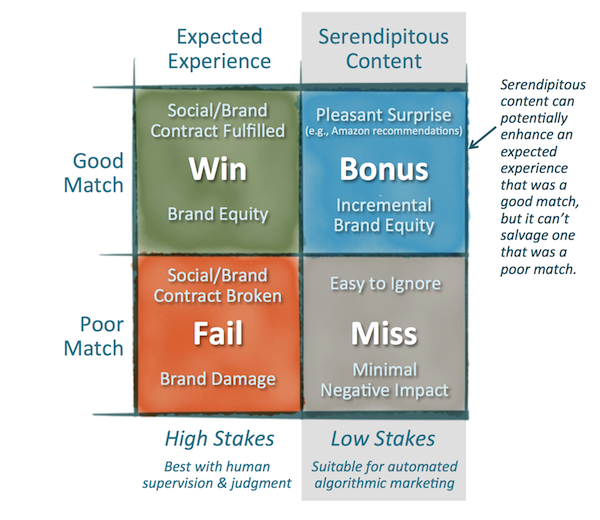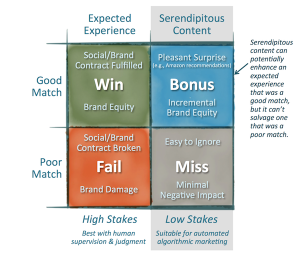Last week, Bank of America suffered brand damage with an automated social media bot. Their intent was good: to automatically detect tweets that mentioned the bank and reach out with an invitation to help. But their algorithm was unable to distinguish between a routine customer service situation and a brand nightmare protest.
The result — a partial clip of the exchange is shown to the right — was a PR train wreck.
It became instantly obvious to everyone that Bank of America’s offers of help — presented as if they came from a sincere human being — were nothing but a tone deaf automaton. People jumped into the thread, baiting the bot and ridiculing its phony replies.
To see more of the exchange, visit Eksith Rodrigo’s blog.
As if that wasn’t bad enough, the debacle caught the attention of many journalists and bloggers, who published stories such as Bank of America’s Epic Twitter Fail, Bank of America’s Twitter Account Is One Really Dumb Robot, and Can’t Buy Me Like author Steve Garfield’s column No Ifs, Ands Or Bots.
Oof.
Unfortunately, this is not the first time a marketing team has poked itself in the eye with a computer algorithm. It actually happens a lot — admittedly not always with as much of a public beating.
There might be two knee-jerk reactions to that. The Luddite View: algorithmic marketing is all crap. The Data Fundamentalist View: they simply should have used a better algorithm. And somebody, somewhere, is always selling a better algorithm.
But here at chiefmartec.com, we prefer to take The Pragmatic View of marketing. Software and algorithms can be incredibly powerful tools in modern marketing, but you need to appreciate their limits and know where to apply them wisely.
In that spirit, I offer up the algorithmic marketing matrix at the top of this post.
The crucial difference between expectations and serendipity
There are two different kinds of touchpoints between marketers and customers: those with expectations, and those that are serendipitous. The suitability of automated algorithmic marketing is significantly different between the two.
Advertising is the quintessential example of a serendipitous marketing touchpoint.
Most regular people — not marketers — do not expect much from advertising. If they happen to see an ad that is beneficial to them — “Hey, that’s right, Mother’s Day is coming up, and I should send flowers!” — wonderful. It is a pleasant surprise that the ad was useful. Serendipity. On the other hand, if they deem the ad irrelevant or uninteresting, they’ll simply overlook it. Few people get livid that an ad failed to give them something. They didn’t expect it to in the first place.
Recommendations on Amazon.com are another serendipitous example. If Amazon happens to recommend a book that you think is great, that’s a pleasant surprise. Amazon reaps the benefit of an incremental sale. On the other hand, if you don’t like any of their suggestions, you’ll simply pass over them. You probably don’t feel that your trust was violated by them serving a few lukewarm ideas — as long as they didn’t get in the way of what you were on the site to do.
That last little caveat is critical though.
Touchpoints with customer expectations, however, are a different matter entirely. When people consciously engage with a company — or they believe the company is consciously engaging with them in a non-serendipitous fashion — they hold you accountable to a different standard. They expect you to live up to any explicit — or implicit — promises of how that experience would unfold. Note that implicit promises include your brand image and social norms.
If you break that contract — even if it’s unintentional, which it almost always is — they will hold it against you. Your brand is sabotaged in their mind. Depending on the context, they may even become angry and savage you on social media and with old-fashioned word-of-mouth.
Here’s a classic example of an expectation. A prospect does a Google search for “Sarbanes-Oxley data storage requirements” and sees an ad that offers a way to learn more about compliance-friendly data management. They click on it and arrive on a landing page with lots of product content — but nothing about compliance, nothing about Sarbanes-Oxley. In their mind, you broke your promise. You wasted their time. Either you were intentionally baiting-and-switching, or you’re incompetent. Neither helps their impression of your brand.
This kind of disconnect happens with surprising frequency. It’s often the result of siloed marketing management — the people handling the paid search campaigns weren’t in sync with the people managing the landing pages. Frankly, there are many far more egregious examples, where an ad promise a particular price, but the subsequent purchase funnel doesn’t live up to that promise. People can get really mad about such shenanigans, even if it was inadvertent.
Let’s go back to our Amazon example of serendipity. Amazon can be forgiven if it makes a few mediocre recommendations, as long as they don’t interfere with your expectations. You expect that you can search for a book, add the book to your cart, and check out — without having slog through a bunch of upsell interactions. If Amazon suddenly had a pop-up every time you added something to your cart, trying to force you to acknowledge their best guess of what you might also want to buy, the outrage would be explosive.
Bank of America’s wayward Twitter bot also violated expectations.
If it appears that a customer service person is reaching out to offer help, you expect that it is actually a real human being who will exercise empathy and judgment. If it’s a bot — or someone trained to act like a bot — the implied social contract is broken. Brand damage ensues.
Automation is great for serendipity, but dangerous for expectations
Differentiating between expected customer experiences vs. serendipitous content is the key concept in this algorithmic marketing matrix.
This reconciles two parallel movements in modern marketing — the customer experience crowd that is focused intently on fulfilling (or exceeding) expectations and the computational marketing/big data crowd that is focused on using machine learning and predictive analytics to improve marketing performance.
When customer expectations are on the line, you really want human supervision and judgement. The stakes are high here, because if you fail to fulfill expectations, your brand will be damaged.
That’s not to say that data and algorithms can’t be used behind the scenes in expected experiences. By all means, leverage state-of-the-art technologies to identify opportunities for new and improved experiences, better audience segmentation, and more optimal flows through the buyer’s journey. Use predictive analytics — maybe even advanced marketing simulations — to better qualify which offers and content you’re going to distribute. Harness big data analysis to inspire marketing experiments.
But a human marketer stays in the loop.
This is more feasible than you might think, even with the fragmentation of marketing channels, because the number of places where you have expected experiences are much fewer than the explosive number of serendipitous marketing touchpoints.
With serendipitous touchpoints, the balance shifts in favor of automated algorithmic marketing. The number of potential touchpoints here is much larger — imagine all the places where advertising, promotional offers, or recommendations may appear. The downside risk is much lower. The upside potential is usually modest — for instance, an estimated 10% of Amazon’s book sales come via their recommendation engine. That’s significant, but it’s more bonus than core business. It probably wouldn’t be worth it to have hands-on human effort applied to individual opportunities for that lift.
Many of these serendipitous touchpoints lend themselves to exactly the kind of tasks that computers are good at: sorting through a huge amount of data, analyzing possible clusters, and taking a probabilistic “best guess” for what would be a good match. And then learning, based on which of those best guesses successfully evoke a serendipitous response, how to make better guesses moving forward.
Predictive technologies are not bottled clairvoyance or magic pills for omniscience. They cannot foretell the future — and vendors who overpromise in that direction are doing themselves and their customers a disservice. When applied properly, in circumstances that are suitable, predictive analytics are simply statistically better than guessing.
You can be pragmatic about that and still harness incredible power.
Eric Siegel, the godfather of modern predictive analytics calls this The Prediction Effect: a little prediction goes a long way. If your algorithm is 20% better than a random guess, that can make a huge difference in your outcome over many runs. It doesn’t have to be 100% right to be immensely valuable.
But — here’s the key caveat — if the algorithm is wrong with a serendipitous touchpoint, it’s merely a missed opportunity. If the algorithm is wrong with an expected experience, it will sabotage your brand.






Very good points, Scott. Automation is dangerous if left in the wrong hands. Follow it all the way through and use great caution is the best approach.
Thanks also for being a great guest on Marketing Made Simple TV too, Scott. I promise to redit and republish your correct show soon too.
Jeff Ogden, the Fearless Competitor
Creator and Host of Marketing Made Simple TV
http://www.marketingmadesimple.tv
Thanks, Jeff — really enjoyed the chat we had!
I’ll update this post when you have the revised show:
https://chiefmartec.com/2013/07/convergence-of-marketing-and-technology-interview/
Scott,
This is a great post, and I love your matrix. With permission, and appropriate reference, I will use it.
Allen Roberts..
Hi, Allen — I’m glad you like the matrix! Please do feel free to use with attribution anywhere you’d like.
Great post Scott. The Alchemy of auto vs hands-on marketing is an interesting topic. Serendipitous Marketing works if its defining alternatives/complementors to a product/service. But does not seem to have a place in managing ANY experience. Thoughts?
I think the distinction is in the word “managing.”
I believe that technology can have tremendous power in delivering great customer experiences. But — in contrast to serendipitous marketing tocuhpoints — expected experiences are best managed by human marketers who apply and oversee such technology with much greater control.
Agree 100%
So I ultimately agree that automation has a place in the marketer’s toolbox but this draws sharp attention to a growing issue in marketing: dehumanization. Marketers are trying to be efficient. They are trying to be effective. They are trying to have the most bottom-line impact with the least amount of effort. Makes sense. But not when the target is people. The marketer’s ultimate objective is to engage (well, at least it’s becoming so thanks to the digital world). But are they engaging if they are automating? Are they losing sight of the fact that there are actual people tweeting them and Facebooking about their brand…and not machines? Or maybe this is just about an acceptable amount of “collateral damage”? Bank of America has demonstrated that no matter how intelligent the system, no matter how complex the algorithm, automation undermines what marketers need to focus on most: relationships.
http://www.rethinkeverythingblog.com/humanizing-marketing/
@_jasonthibeault
Excellent points, Jason. I really like your post on humanizing marketing.
When the purpose is to engage with a customer, I agree, it should be a human-centric endeavor. Maybe not one-to-one — Amazon doesn’t need individual human store reps handling my check-out — but supervised closely by a humanist experience designer.
In the case of serendipity, such as advertising, however, that strikes me as a pre-engagement space where computational algorithms may deliver what they do best with minimal risk to the humanity of the organization behind it.
Yes Predictive technologies better than guessing but 100% unsupervised statistical predictive machine learning engines has flaws as you pointed out in article.
Why you need methods like supervised + unsupervised real-time machine learning with reasoning to discover correlations and patterns of similarity with anticipatory and prescriptive analytics.
Very interesting thoughts, Scott. Your post reminds me of the chapters in Thinking, Fast and Slow that discuss human judgement vs algorithms. The studies that Kahneman points to suggest that algorithms are statistically superior to human judgment (in the same, imperfect way that you describe), that complex algorithms typically don’t outperform simple ones, and that humans can add value to the extent that they have specific situational experience. To me, this means that in a resource-constrained world, marketing teams should focus on two things: 1) (relatively) simple automation and 2) intense study of their customers/market. A technology portfolio that allows marketers to easily feed customer knowledge back into the (simple) algorithms ties it all together.